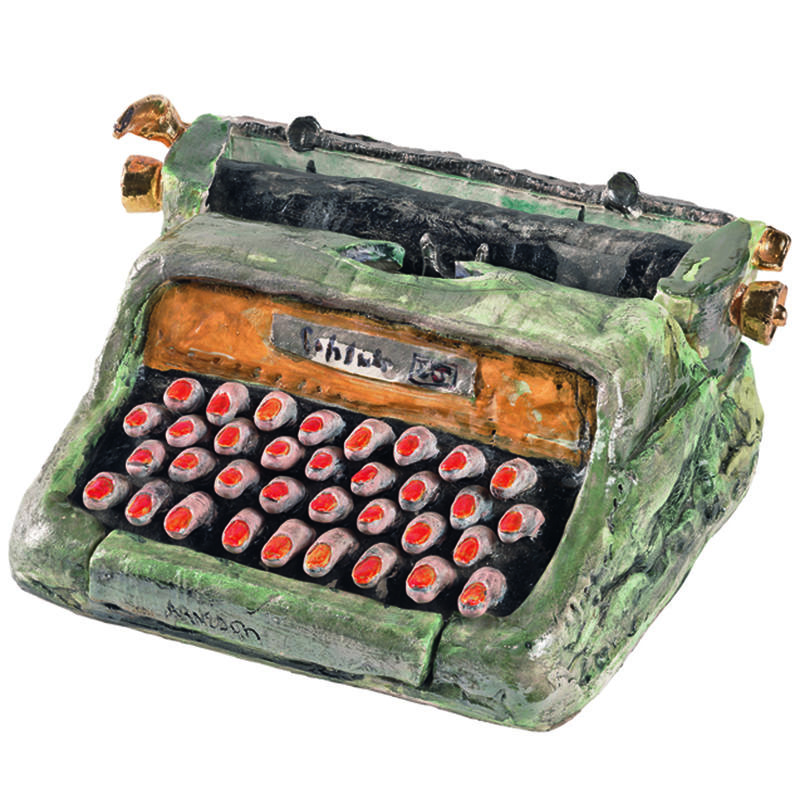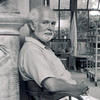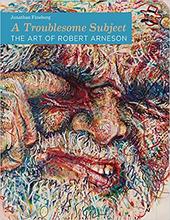More about Typewriter
- All
- Info
- Shop

Contributor
My homeboy Robert Arneson, king of Bay Area Funk, created some gnarly sculptures of ordinary objects such as Typewriter.
Not one to shy away from excess of materials, Typewriter is smaller-than-lifesize rendition of the now archaic machine. I, a proud millennial, can admit I’ve never used a typewriter in my life; and I know there are many gen Z-ers today who don’t even know what a typewriter is, or fun-fact, an eggbeater-- spoiled rotten tech junkie kiddos!
Created in 1965, Arneson’s Typewriter is a primo example of the artist’s influence as one of the Bay Area’s funk artists who taught at UC Davis. A native to my hometown Benicia, CA--that town you see on 680 on the way to the mountains, you know the one you judge because all you see is the Valero refinery and think, "How can any one live there?" Well folks, jokes on you because, like Arneson, there are a select 30,000 or so Bay Area natives who have found charm of Benicia with it’s almost panoramic water views and cute downtown home, and guess what? Only you can see the refinery, when you are actually in town there is no such trace of Valero’s Emerald City. In fact, we thank Valero for the refinery as it has significantly lowered home values in town giving us Sausalito views with middle class (-ish) prices. Take that Bay Area snobs.
Speaking of Benicia, that is exactly where Arneson began his career. While in high school at my very own Benicia High, Arneson took a pottery class where he began to explore the medium in more depth. In addition, his first job while in high school was as a cartoonist at the Benicia Herald, which still exists today (somehow).
Arneson’s ceramics evoke the Funk Art mentality of crude jokes made using trompe l’oeil; a technique which uses realistic imagery to create an optical illusion. Typewriter here uses this theme by depicting red fingernails in lieu of the keyboard interface we are accustomed to seeing in a real-life typewriter. Using erotically-charged red fingernails as the modus-operandi for this piece, Arneson touches on ideas of Surrealism, elevating pottery and ceramics into their rightful place as worthy mediums of fine art. Arneson’s mission was to disprove the notion that pottery is craft and, like other mediums of art, deserves to be recognized by the snobs of society.
Although we today celebrate Robert Arneson for his part in elevating ceramics into the canon of fine art history, many critics of the time saw him as immature. Partially unwilling to let go of satirical themes in his artwork, Arneson challenged the idea that art couldn't be humorous. He had stated, “'Humor is a problem in art' and whenever you get involved with humor, people take it personally and become offended. But you can’t not offend anyone in dealing with tragedy. I am willing to do it, and take a lot of horsesh*t from the critics for doing it. Yes, it is sophomoric, but I am sure much of our young culture is sophomoric. Should I be beyond that?”
In short, Arneson stayed true to his convictions, forced the art world to reckon with the fact that ceramics is truly a high art form, and turned us, the viewer, into a believer that humor and art go together like red nails and a typewriter.
Sources
- Arneson, Robert. Typewriter. 1965. Permanent Collection, Berkeley Art Museum and Pacific Film Archive, Berkeley, CA. Accessed September 17, 2018. https://webapps.cspace.berkeley.edu/bampfa/search/search/?maxresults=1&….
- Sintetos, Mike. "Robert Arneson: Serious Ideas Behind That Humor." UC Davis Arts and Culture. 2006. Accessed September 17, 2018. Arneson, Robert. Typewriter. 1965. Permanent Collection, Berkeley Art Museum and Pacific Film Archive, Berkeley, CA. Accessed
- Kessler, Pamela. "Robert Arneson: Pottery Poetry." The Washington Post, May 9, 1986. Accessed September 17, 2018. https://www.washingtonpost.com/archive/lifestyle/1986/05/09/robert-arne…
- Merriam-Webster.Accessed September 17, 2018. https://www.merriam-webster.com/dictionary/trompe l'oeil.
- "Robert Carston Arneson." University of Iowa Stanley Museum of Art. Accessed September 17, 2018. https://uima.uiowa.edu/collections/ceramics/robert-carston-arneson/.
- "Robert Arneson." Artnet. Accessed September 17, 2018. http://www.artnet.com/artists/robert-arneson/.












